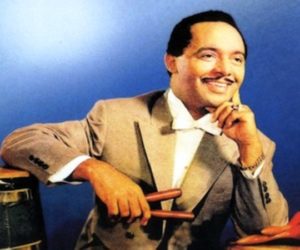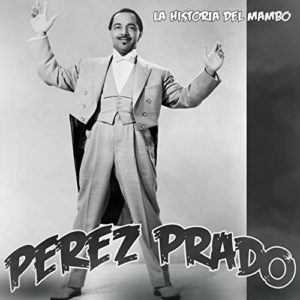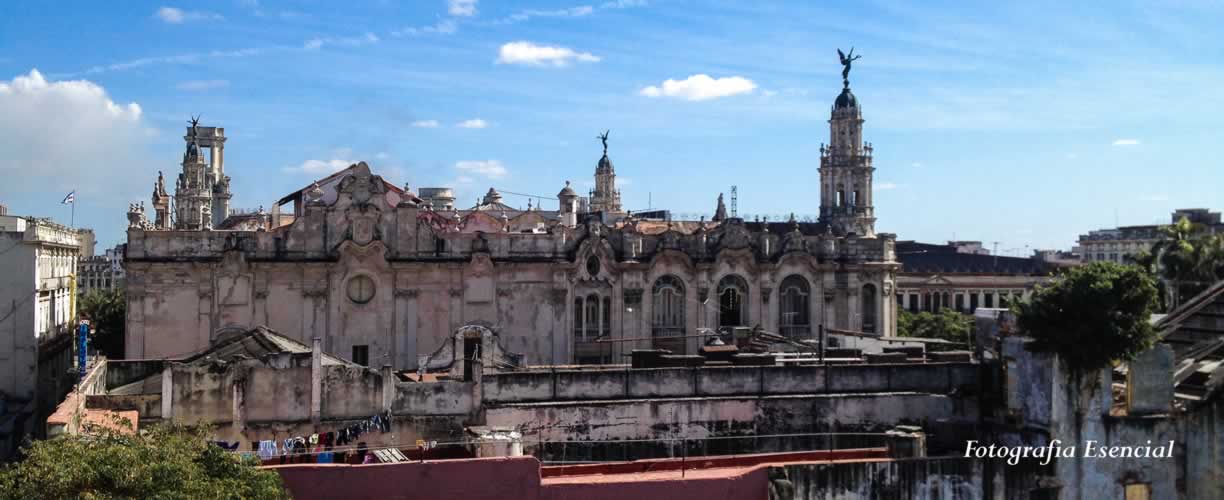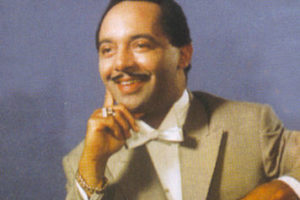 DAMASO PÉREZ PRADO Y LA REVOLUCIÓN MUSICAL “EL MAMBO”. VIDEOS.
DAMASO PÉREZ PRADO Y LA REVOLUCIÓN MUSICAL “EL MAMBO”. VIDEOS.
Dámaso Pérez Prado nació en la ciudad de Matanzas el 11 de diciembre de 1917 y falleció en México el 14 de septiembre de 1989. Fueron sus profesores Rafael Somavilla Pedroso y María Angulo y su carrera se inició en su provincia natal como integrante del conjunto de otro de los grandes exponentes de la música cubana: Senén Suárez.
Pérez Prado se trasladó a La Habana en 1941, aquí trabajó como pianista en las orquestas de los cabarés El Kursal, Panchín y Pennsylvania, después pasó a laborar en las agrupaciones de Paulina Álvarez, los Hermanos Palau, Julio Cueva, en la Casino de la Playa, la del circuito CMQ y la Cubaney, en la que se interpretaron sus primeros arreglos musicales.
En uno de los viajes que Damaso Perez Prado dió a Mexico, país que lo acogio como el suyo, cuenta un chiste cubano que cuando subian al avion que los llevaria hacia la capital azteca un aduanero sospechó de uno de los miembros del conjunto porque no portaba un instrumento musical. El individuo en cuestión le explicó al funcionario que él era el integrante más importante de la orquesta, pues era el encargado de propiciar que Pérez Prado le surgiera su famoso grito cuando interpretaba sus composiciones: ¡Huuugg!
Lo cierto es que el grito que se escucha en medio de las famosas piezas del músico matancero es algo característico, pero, hablando en serio, no es esa la mayor peculiaridad del mambo, sino su ritmo contagioso que hace estremecer al cuerpo cuando se baila.
Aunque se reconoce a Dámaso Pérez Prado como el creador del popular ritmo, a finales de la década de los 40 y principios de la de los 50, no es menos cierto que sus antecedentes se remontan diez años más atrás, cuando los hermanos Orestes e Israel López, integrantes de la orquesta Arcaño y sus Maravillas, crearon una variante del danzón con un compás más rápido y le introdujeron una sincopa en la percusión, característica propia de la música africana.
Antonio Arcaño fue el primero en denominar a una parte de esos danzones como “mambo” y a finales de la década de los 30 el músico José Urfé incluyó en su pieza El bombín de Barreto un montuno al estilo del son cubano. Ya en esa época algunos músicos de la orquesta de Arcaño le llamaban “mambear” a interpretar esa parte de los temas musicales.
Arcaño describió ese “mambo” de la manera siguiente: “El mambo es un tipo de montuno sincopado que posee la sabrosura rítmica del cubano, su informalidad y su elocuencia. El pianista ataca en el mambo, la flauta lo oye y se inspira, el violín ejecuta rítmicos acordes de dobles cuerdas, el bajo le adapta el “tumbao”, el timbalero repica con el cencerro, el güiro rasquea y hace el sonar de las maracas, la indispensable tumba corrobora el tumbao del bajo y fortalece el timbal”.
Fue Orestes López quien creó primer danzón llamado precisamente ‘Mambo’ en el que se combinaban elementos sincopados, tomados del estilo del son, con improvisaciones de la flauta.
Luego el pianista y arreglista matancero Pérez Prado, a finales de 1949 presentó en México un ritmo totalmente nuevo al que llamó mambo y con el cual logró gran éxito.
El nuevo ritmo se identifica con un formato de orquesta de jazz y percusión cubana desde la exigencia de Pérez Prado, o sea, una instrumentación ampliada dispuesta por cuatro o cinco trompetas, cinco saxofones, trombón, flauta, piano, contrabajo, batería, maracas, cencerro, bongó y tumbadoras.
A propósito del tema el investigador, escritor, saxofonista y musicólogo cubano Leonardo Acosta comentó: “Yo diría que Pérez Prado tomó algo más: precisamente ese “guajeo” o “montuno sincopado” que se llamó mambo, y que en aquellos años 40 eran el sello que caracterizaba “la onda” o “la moña” Pero en el mambo de Dámaso también están presentes la guajira (en el mambo caén), la rumba (en el mambo batiri, más rápido), el propio danzón y hasta el jazz”.
La palabra “mambo”, de manera similar a otros términos musicales afroamericanos, se deriva de un lenguaje africano, particularmente el congolés. Algunos estudiosos la traducen como “cosa” u “objeto”, para otros su significado es “conversación con los dioses”, “conversación” y “conocimiento”. También se les llama de esa forma en Haití a las sacerdotisas de la religión vudú. Pero, lo cierto es que en la actualidad, y gracias a la genialidad de Dámaso Pérez Prado, en todo el mundo la palabra referencia el pegajoso ritmo que hace a los bailadores mover la cintura y los hombros, como recalca el texto del mambo Bonito y sabroso, de Benny Moré, otro exitoso cultivador de ese género musical.
Su desempeño como instrumentista fue indudablemente, pero lo que en realidad dio fama a este músico fue el mambo, un ritmo que le trascendió y continúa vivo para bien de la cultura cubana.
 DAMASO PEREZ PRADO AND THE MUSICAL REVOLUTION “EL MAMBO”. VIDEOS.
DAMASO PEREZ PRADO AND THE MUSICAL REVOLUTION “EL MAMBO”. VIDEOS.
Dámaso Pérez Prado was born in the city of Matanzas on December 11, 1917, and died in Mexico on September 14, 1989. His teachers were Rafael Somavilla Pedroso and María Angulo and his career began in his home province as a member of the group of other of the great exponents of Cuban music: Senén Suárez.
Pérez Prado moved to Havana in 1941, where he worked as a pianist in the orchestras of the cabarets El Kursal, Panchín and Pennsylvania, then went on to work in the groupings of Paulina Álvarez, the Palau Brothers, Julio Cueva, in the Casino de la Playa, that of the CMQ circuit and the Cubaney, in which his first musical arrangements were performed.
In one of the trips that Damaso Perez Prado gave to Mexico, a country that welcomed him as his own, a Cuban joke tells that when they got on the plane that would take them to the Aztec capital a customs officer suspected one of the members of the group because he did not carry a musical instrument. The individual in question explained to the official that he was the most important member of the orchestra, as he was responsible for encouraging Perez Prado to give him his famous shout when he interpreted his compositions: Huuugg!
The truth is that the scream that is heard in the middle of the famous pieces of the Matanzas musician is something characteristic, but, seriously speaking, that is not the greatest peculiarity of the mambo, but its contagious rhythm that makes the body shiver when it is danced.
Although Dámaso Pérez Prado is recognized as the creator of the popular rhythm, at the end of the 40s and the beginning of the 50s, it is no less true that his background goes back ten years, when the Orestes brothers and Israel López, members of the Arcaño Orchestra and its Wonders, created a variant of the danzón with a faster beat and introduced a syncopa in percussion, characteristic of African music.
Antonio Arcaño was the first to name a part of those danzones as “mambo” and at the end of the 30s, the musician José Urfé included in his piece El bombín de Barreto a montuno in the style of Cuban son. Already at that time, some musicians from the Arcaño orchestra called him “mambear” to interpret that part of the musical themes.
Arcaño described that “mambo” as follows: “The mambo is a type of syncopated montuno that possesses the rhythmic taste of the Cuban, his informality and his eloquence. The pianist attacks in the mambo, the flute hears and is inspired, the violin performs rhythmic double-chord chords, the bass adapts the “tumbao”, the timbalero chimes with the cowbell, the güiro scratches and blows the maracas , the indispensable tomb corroborates the bass tomb and strengthens the timbale. ”
It was Orestes López who created the first danzón called precisely ‘Mambo’ in which syncopated elements were combined, taken in the style of son, with improvisations of the flute.
Then the Matanzas pianist and arranger Pérez Prado, at the end of 1949 presented in Mexico a totally new rhythm to what he called mambo and with which he achieved great success.
The new rhythm is identified with a format of Cuban jazz and percussion orchestra from the requirement of Pérez Prado, that is, expanded instrumentation arranged by four or five trumpets, five saxophones, trombone, flute, piano, double bass, drums, maracas, cowbell, bongo and tumbadoras.
Regarding the subject, the Cuban researcher, writer, saxophonist and musicologist Leonardo Acosta commented: “I would say that Pérez Prado took something else: precisely that” guajeo “or” syncopated montuno “that was called mambo, and that in those 40s they were the seal that characterized “la onda” or “la moña” But in the mambo of Dámaso there are also the guajira (in the mambo caén), the rumba (in the mambo batiri, faster), the danzón itself and even jazz ” .
The word “mambo”, similar to other African-American musical terms, is derived from an African language, particularly Congolese. Some scholars translate it as “thing” or “object”, for others its meaning is “conversation with the gods”, “conversation” and “knowledge”. They are also called that way in Haiti to the priestesses of the Voodoo religion. But, the truth is that today, and thanks to the genius of Dámaso Pérez Prado, worldwide the word reference the sticky rhythm that makes the dancers move the waist and shoulders, as emphasized by the text of the Mambo Bonito and Tasty, by Benny Moré, another successful cultivator of that musical genre.
His performance as an instrumentalist was undoubtedly, but what really made this musician famous was the mambo, a rhythm that transcended him and is still alive for the good of Cuban culture.
Agencies/ Radio Encycl./ Gilberto Gonzalez/ Internet Photos/ YouTube/ Arnoldo Varona/ www.TheCubanHistory.com
THE CUBAN HISTORY, HOLLYWOOD.



 < DAMASO PÉREZ PRADO and the Musical Revolution "EL MAMBO". Videos.
< DAMASO PÉREZ PRADO and the Musical Revolution "EL MAMBO". Videos.





